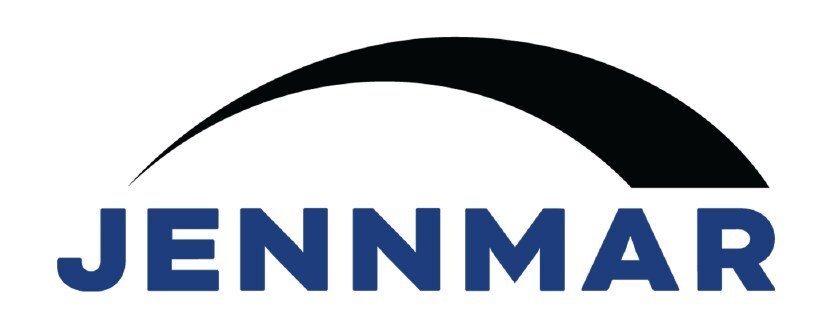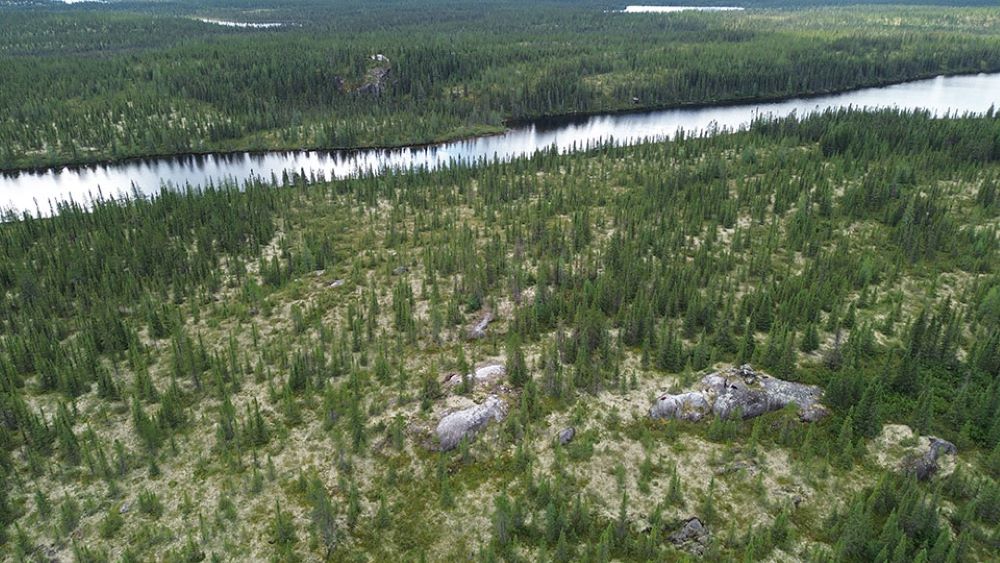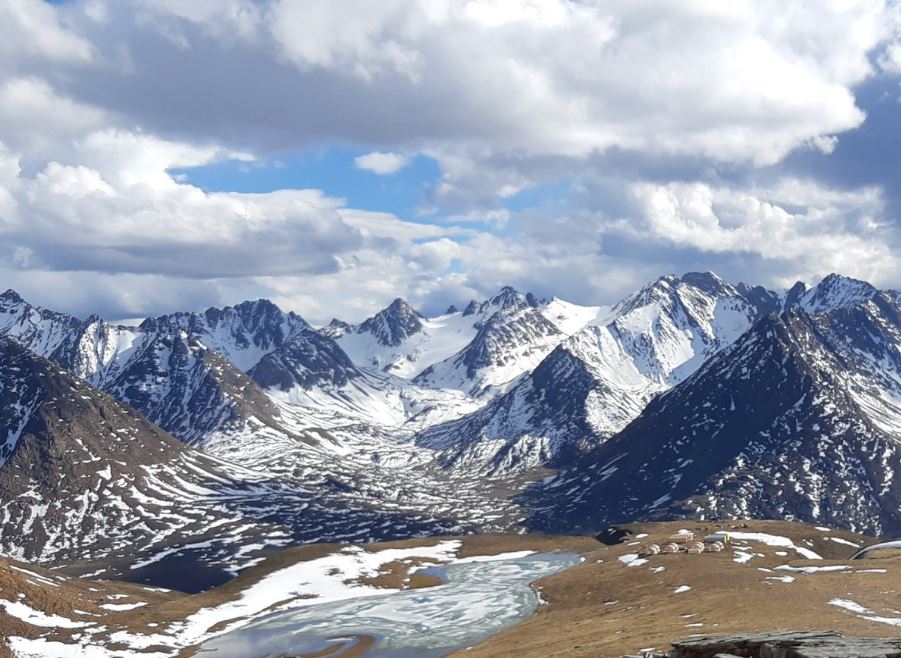Great Gusto
Their cargo: three slender slate-grey epoxy resin wind turbine blades, each 35 metres long, set for the 320 kilometre, 20-hour trundle up the Tibbitt to Contwoyto winter road to the Diavik Diamond Mine. They would be the vanguard of 60 loads needed to build a quartet of wind generators that will tower 100 metres above the Arctic skyline.
For Liezl van Wyk, Diavik’s energy advisor and project mastermind, it was her first tangible touch of an idea that had consumed her for almost two years. She paced the length of each truck with delight, marvelling at the blades’ elegant contours, as the team of long-haul drivers from Equipment Express prepared for the final leg of their journey.
“To actually see their shape and size, it was very inspiring… it was really a fantastic event,” she said later.
van Wyk had every reason to be inspired, as the 9.2 megawatt wind farm will be the world’s first and biggest of its kind at any remote mine site. With its $30 million commitment, Diavik is ushering in a new level of technology that may help mines and communities alike reduce one of the toughest barriers to a viable and sustainable north: energy.
It’s just going to take tenacity
It’s a dream project for the Namibia-born van Wyk. With a Masters in Electrical Engineering from South Africa, specializing in high voltage transmission, as well as an MBA from Switzerland, it was Diavik’s call for an energy strategist that brought her to Canada’s Arctic, a place drastically unlike her native Africa.
She was offered the job in January 2010 as Principal Advisor, Energy, and still in South Africa, she was handed three years worth of site wind data and asked, “Can you investigate this as a feasible option?”
One of the key numbers she worked with was the relatively fixed and astronomical cost of generating power by diesel on site, which will help the project show a respectable eight-year payback period.
“I started building a very simple business model; it started expanding; I did more research. I’ve never built a wind farm before,” she says, “but I said, you know what? I don’t think this is going to be difficult. It’s just going to take tenacity.” In a mere six months, by the time she arrived in Canada in July 2010, she had a project package ready to put before DDMI and Rio Tinto directors.
New Cold Weather Threshold
The quartet of German-made Enercon E70 machines, like the impressive scale of the Diavik mine today, will be big. Their blades (equipped with a heated de-icing system) will sweep a 70-metre arc 100 metres above the tundra. The generator nacelle, 64 meters above ground, is the size of a small bungalow mounted on steel towers prefabbed in three sections by Hitachi Canadian Industries in Saskatchewan for Enercon.
Under ideal conditions the four machines will deliver an installed capacity of 9.2 megawatts – equal to about a third of the City of Yellowknife’s average winter demand (their online capacity could actually red-line at 6 mW each in very strong winds).
But wind farms, by the very nature of variable and seasonal winds, can’t consistently give full design output. The Diavik project will still provide 17 gigawatt hours of energy, displacing four million litres of diesel fuel, or about 100 Super B truck loads. They will shave 10 per cent of the mine’s annual diesel consumption and six per cent of the mine’s overall carbon footprint.
The towers will stand as tall white beacons with a noise level below current site levels, away from known bird habitat and flight paths. van Wyk says the impact on caribou is unknown, and will be closely monitored – this will be the first time a wind farm has been built in their habitat.
The huge machines are the same size as those at wind farms in Alberta and BC but dwarfing the more common 1.5 mW units in use worldwide. In the procurement process, van Wyk invited five of the world’s top wind generator builders to bid, and two of them – Enercon GmbH of Germany, and General Electric of the USA – emerged with viable proposals.
She set a demanding new cold weather threshold for them: exceed the current industry operating standard of -30C. “We really pushed them to make it work at –40.”
Enercon’s direct-drive turbine design won out over GE’s gear-box technology with its greater simplicity and reliability, says van Wyk. Enercon also delivered on the -40C guarantee.
During the fall and early winter of 2011, Diavik prepared the tower foundations, lay down area and crane walk pads for the site a few hundred metres from the mine’s process plant and airstrip.
Anything that can’t be flown in to the mine site has to come in via the eight-week season on the 320 km Tibbitt to Contwoyto Winter Road from Yellowknife. The logistics of building the machines in Germany, shipping by ocean, and trucking across Canada to the mine had to be bulletproof.
The plan included trucking in a 300 tonne capacity Liebherr crawler crane, supplied by Mammoet Canada of Alberta, capable of lifting the towers, and the 55 tonne stators and rotors to those heights was also brought in on the winter road.
With everything now safely on site, van Wyk says erection of towers, generator and blades is to continue through the spring and summer, with testing and commissioning for service by late 2012.
Taking the Risk
Like many other aspects of mining in the challenging Arctic regions, setting up the Diavik wind project is a bold and visionary step that’s not for the faint of heart or shallow of pocket.
“And that’s one of the things that Diavik definitely has on its radar; we are well positioned to take the risk,” says van Wyk. “Those capable of taking the risk, should take it… we can handle the price, communities can’t.
“The legacy we would like to leave is to get the risk down on the curve, and then find a design that is going to be useful in small communities.”
Such a project is already underway in Yellowknife. A $450,000 joint venture between Diavik, the NWT and federal governments, and Yellowknife’s Dene Det’on Cho Earth Energy Corporation is using the mine’s 50 metre test tower, donated by Diavik, to study the wind regime at the old Giant Gold Mine site. Yellowknife electrical contractor Ric Bolivar, a wind power advocate and direct with Earth Energy, says they’re hopeful of an Aboriginal-led, community project.
After the mine’s closure a decade or so from now, van Wyk says the wind machines should still have years of service left and the intention is to give the machines to an NWT community with a feasible plan.
The Diavik project is also a milestone for Enercon in Canada, says Marc-Antoine Renaud, Business Development Manager in Montreal. Building on experience in Antarctica, Renaud says it is “really a breakthrough for the entire industry,” spurring a new level of Canadian expertise in cold-weather wind power. Renaud expects it will gain momentum as both Ontario and Quebec seek to open their northern regions to more mining action.
“The NWT took the lead, and there’s a lot that can be learned from that experience,” said Renaud.
It promises to be yet another legacy of the NWT’s diamond miners, who have already set new bars for the technology, transporta
tion and logistics needed to make remote and complex industry doable and profitable North of 60.





Comments